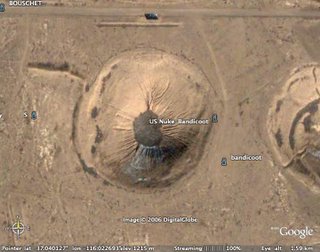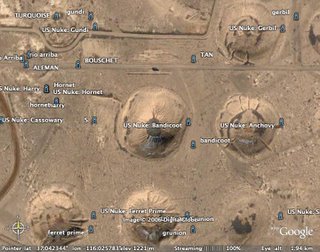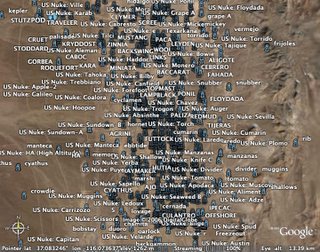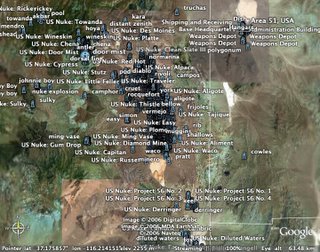Nuclear Test Sites
As we were both experimenting with Google Earth tonight, Neal pointed out an area in Nevada to me. You can see the crater where an atomic bomb in the 100 kiloton range was tested:

Surrounding it are more test sites:

They sure felt the need to make sure these things would work:

It definitely makes you more certain that Eisenhower was on to something when he talked about a military-industrial complex in his farewell address:

In the words of Ike: "Every gun that is made every warship that is launched every rocket fired, signifies, in the final sense, a theft from those who hunger and are not fed, those who are cold and are not clothed"

It really defies all belief, doesn't it?

8 Comments
According to Wikipedia
Between 1951 and 1992, there were a total of 925 announced nuclear tests at Nevada Test Site. 825 of them were underground (seismic data has indicated there may have been many unannounced underground tests as well). The site is covered with subsidence craters from the testing [1]. The Nevada Test Site was the primary testing location of American atomic bombs; only 129 tests were conducted elsewhere (many at the Pacific Proving Grounds in the Marshall Islands).
On July 17, 1962 the test shot "Little Feller I" of Operation Sunbeam became the last atmospheric test detonation at the Nevada Test Site. Underground testing of weapons continued until September 23, 1992, and although the United States did not ratify the Comprehensive Test Ban Treaty, the articles of the treaty are nevertheless honored and further tests have not occurred. Tests not involving fission continue.
In a report by the National Cancer Institute, released in 1997, it was determined that ninety atmospheric tests at the Nevada Test Site deposited high levels of radioactive iodine-131 (5.5 exabecquerels) across a large portion of the contiguous United States, especially in the years 1952, 1953, 1955, and 1957—doses large enough, they determined, to produce 10,000 to 75,000 cases of thyroid cancer. In 1993, residents living near the Nevada Test Site were included in the Radiation Exposure Compensation Act, 1,375 claims were honored (1,121 were denied). As of 2004, the test site offers public tours on approximately a monthly basis, although the taking of souvenir material is prohibited.
Interesting... and scary. Like the details of the Teller-Ulam design, such as they are known.
Speaking of scary photos, here's one of a MIRV test.
For the uninitiated, a MIRV is a (usually nuclear-tipped) missile that is capable of delivering multiple, independently targeted nuclear weapons into a theatre of operations. Each warhead could be set to strike a different city or missile base, greatly multiplying the potential destructive power of a single missile.
The negotiations on the use of MIRVs made up a critical component of nuclear limitation talks between the Americans and Soviets during the later decades of the Cold War.
Guess Ike would have been tarred and feathered and "rode outta town on a rail" today. When I was teaching Advanced Placement Government & Politics, students found it hard to believe that a Republican military-man President could have uttered such a statement. Great warning, though, Ike. Shame no one heeded it.
Terrific series of photos, btw.
This post is discussed on this rocketry related blog.
"As Ed Grothus will tell you, an atomic bomb looks like a soccer ball. The central core of the bomb is made of a radioactive metal such as plutonium or uranium that's constantly sending off alpha particles. Around it are placed hexagonal and pentagonal explosive charges that look like the faces of a soccer ball.
To detonate the bomb, these charges are simultaneously set off. The key word, here, is simultaneously; in order to work, the charges have to detonate within a few hundred millionths of a second of one another. Designing the charges and the detonation mechanism were two of the major achievements of the Manhattan Project.
When the charges are detonated, they compress the radioactive core very fast and very hard, which causes it to become smaller and denser -- more massive, in other words. Past a certain point, this causes a chain reaction, in which the nucleus of the plutonium atoms begin to split. This releases massive amounts of both gamma radiation and kinetic energy in a matter of milliseconds.
In other words, a nuclear explosion."
(Link)
Nuking Mississippi
It really happened in the 1960s. Called (for some reason) Project Dribble, the purpose was to give U.S. scientists experience in detecting underground nuclear tests in the Soviet Union. The first blast, a 5.3 kiloton bomb, took place in 1964 at the bottom of a 2,710-foot shaft 28 miles southwest of Hattiesburg and four miles northeast of Baxterville. The second bomb, much smaller, was exploded two years later within the cavity created by the first blast. (To be sure, these were only two of well over a thousand documented nuclear tests by the United States, with the vast majority taking place in Nevada.)
Since this page seems to get so many hits from people interested in all things defence related, I will put a link here to the report I prepared for the Canadian Department of National Defence. As part of the research, eight other UBC students and I visited NORAD, USNORTHCOM, the Air Force Space Command, and the Air Force Academy:
Common Threats, Joint Responses: the Report of the 2005 North American Security Cooperation Assessment Student Tour (PDF)
Post a Comment
« Home